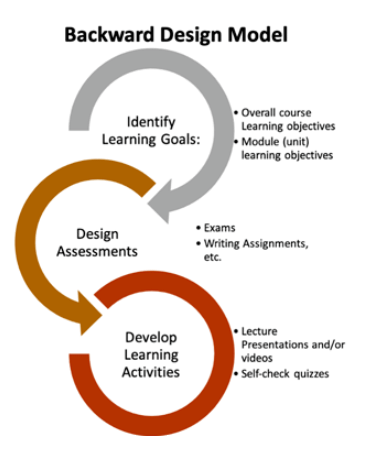Backward Design, Learning Objectives, and Alignment
What is the Backward Design Model?
 The Backward Design model is a student-centered course design model in which instructors/course designers take an intentional approach to course design.
The Backward Design model is a student-centered course design model in which instructors/course designers take an intentional approach to course design.
There are three phases in the Backward Design model. First phase is to identify the overall course objectives; what do we want student to be able to do at the end of the course? Then we need to break these objectives into manageable, more specific, and discrete unit learning objectives. Each course objective should be aligned to at least one unit objective and vice versa.
Then, we need to think of the evidence needed to demonstrate students’ achievement of the stated learning objectives. For example, the type of assessment that will assess students' achievement and the level of proficiency of the intended learning objective. Remember that assessments do not have to be quizzes, tests, or exams, but can be any form of demonstration by the student of their understanding or competency.
In the last phase, we will plan the learning experiences and instructions students need to practice and develop their knowledge and skills. We need to consider instructional materials and learning activities that will contribute to the students’ knowledge to help them successfully complete the assessment and achieve the learning objectives.
Learning Objectives
Learning Objective is a written statement that describes what students will be able to do at the end of the course, chapter, module, or unit. We will need to write overall course-level objectives as well as learning objectives for each course unit/module.
Terminology Clarification: Learning Objectives versus Learning Outcomes:
Sometimes people use the terms Learning Objectives and Learning Outcomes interchangeably, but there is a difference. A learning objective is a written statement that describes precisely and clearly what the course, chapter, module, or unit aims to do or have students achieve. Sometimes also referred to as learning goals, these objectives describe intent.
A learning outcome, on the other hand, describes in observable and measurable terms what a student can do as a direct result of completing a learning experience (e.g., course, project, or unit). These are tangible and observable deliverables or demonstrations that your assessments measure.
For example, “Climb Mount Everest” is the objective – the intent or goal. A selfie at the top of Mount Everest is the outcome – an observable achievement as a direct result of successfully meeting the objective.
Course vs. Unit/Module Objectives
Course level objectives are much broader in scope than unit/module level objectives. Module objectives describe student skills and knowledge in specific, observable terms and in small discrete pieces, while course objectives describe student ability and higher-level thinking skills. In a module, we may have 10 or more objectives supporting all the tasks or skills involved in the module learning a concept. But in a course, we might only have 4-6 objectives. Each course objective must be supported by one or more module objective.
Effective learning objectives are observable, and measurable and must be described using action verbs to identify what we want students to be able to do by the end of the course or unit. Developing course activities and assessments to meet the course expectations and align with the intended objectives is much easier when we have measurable objectives from the beginning.
Why is it beneficial to develop courses using Backwards Design?
Backwards Design helps to ensure your course is mapped so that your all components of your course work together to support each other. This sets students up for success in learning the instructional content and applying what they learned in ways that demonstrate their achievement of the desired learning objectives. By developing your course to align to the course learning objectives, you are taking a student-centered approach to course development because you are ensuring that your assessments are set up to scaffold and measure the concepts and skills that comprise the course objectives, which in turn ensures that the content and activities you provide those students to successfully complete course assessments are directly relevant to what they will be assessed on. This provides students with a focused, transparent learning experience, as they are able to see and understand how your course design supports their learning experience.
What are the challenges in applying the Backwards Design Model to course development?
Often, faculty select a textbook and then develop a course around the textbook. Unfortunately, once a course has been designed, many faculty do not take the time to review the course through a Backwards Design lens to ensure the textbook, activities, assignments, and assessments (especially if using publisher content), all work together to support the learning objective the student is meant to achieve. This often leads to students feeling that they are doing 'busy work' because the do not see a connection between the course work and the course outcomes. Investing the time, and critical eye, to reflect on existing courses is the greatest challenge is applying Backwards Design to courses at SU.
How can you apply the Backwards Design Model to a new or existing course?
At SU you can learn more about the Backwards Design Model a couple of different ways, based on your interest and needs.
You can:
- Enroll in the self-paced course
- Consult with your departmental
